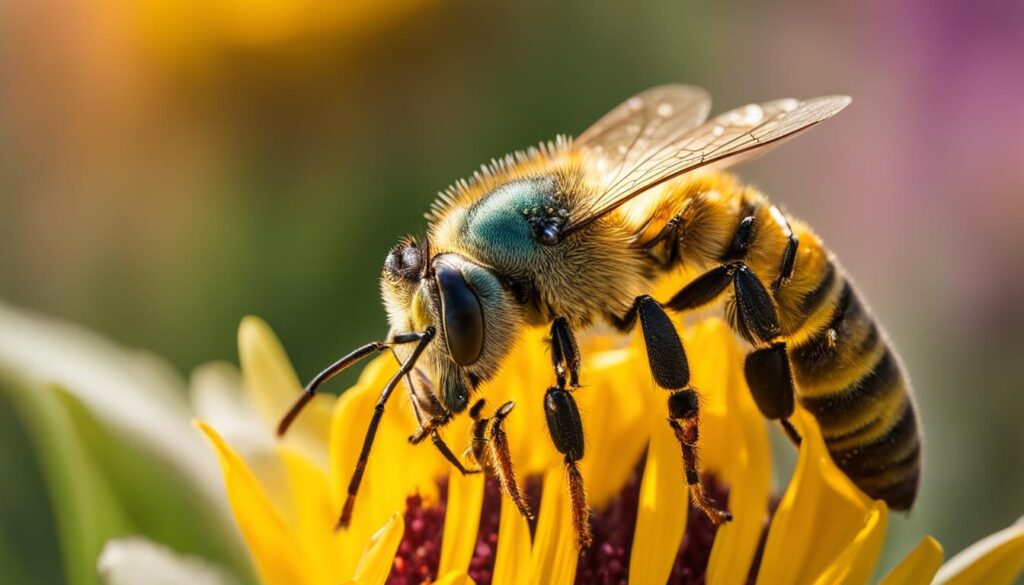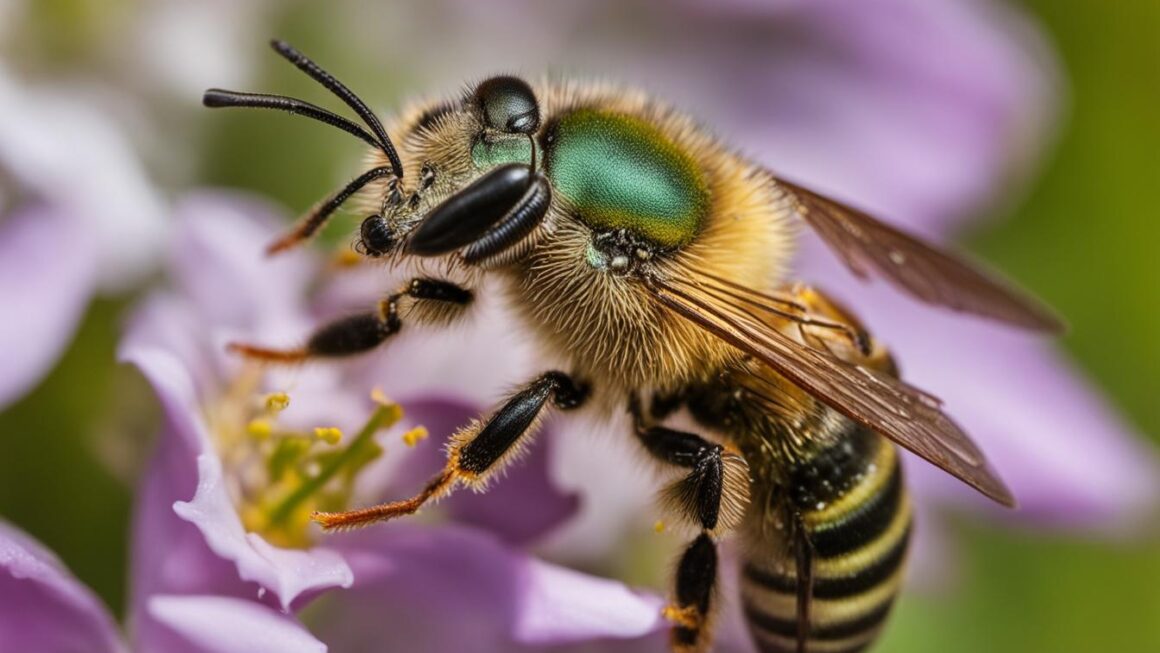Sweat bees are a fascinating species of bees known for their unique habits and behaviors. As they are a lesser-known species of bee, many people wonder if they produce honey like other bees. In this section, we will explore the world of sweat bees and answer the question: do sweat bees make honey? We will delve into their honey production capabilities and shed light on the process of sweat bee honey production.
Key Takeaways:
- Sweat bees are a lesser-known species of bee.
- Many people wonder if sweat bees produce honey like other bees.
- In this section, we will explore sweat bees’ honey production capabilities and process.
- Sweat bee honey production is unique and fascinating.
- Understanding the role of sweat bees in honey production adds depth to the world of bees and the valuable products they create.
Understanding Sweat Bees
Before we explore the topic of sweat bee honey production, it’s important to gain a better understanding of these tiny creatures. Sweat bees are a diverse group of bees that belong to the Halictidae family and are commonly found across the world, with over 1,000 species identified to date.
Sweat bees are named for their attraction to human perspiration, which they use for hydration and to obtain nutrients. However, their primary food source is flower nectar, which they collect and transform into honey.
Sweat bees are typically small, ranging from 3 to 10mm in length, with a slender body and a colorful, often metallic appearance. They come in a variety of colors, including black, green, and blue, and some species have bands or stripes on their abdomen.
These bees are solitary or social, with some species nesting in the ground, while others build their nests in trees, shrubs, or other plants. Their nesting habits vary by species, with some living alone in burrows, while others form large colonies with multiple females.
Behavior and Habitat
Sweat bees are active during the day and are attracted to sunny areas with plenty of flowers. They are important pollinators for many plant species, including crops like tomatoes and blueberries.
Unlike honey bees, which live in large colonies and store honey in elaborate hives, sweat bees are solitary or social and store their honey in simple, small structures. These bees construct their nests out of mud, plant fibers, or resin, and may create tiny honey pots to store their nectar.
Many species of sweat bees are ground-nesters, digging nests in soil banks, sandy areas, or lawns. Others nest in cavities found in wood, stems, or hollow twigs, or use pre-existing cavities in rocks or decaying wood.
“Sweat bees are named for their attraction to human perspiration, which they use for hydration and to obtain nutrients.”
| Sweat Bee Species | Behavior | Habitat |
|---|---|---|
| Agapostemon | Social | Ground-nesting |
| Dialictus | Solitary | Ground-nesting |
| Lasioglossum | Solitary or social | Ground-nesting, nest in twigs or rock crevices |
| Habropoda | Solitary | Nest in hollow stems or decaying wood |
With their diverse appearances, nesting habits, and behaviors, sweat bees are a fascinating and vital part of our ecosystem. Now that we have a better understanding of these bees, let’s delve into their role in honey production.
The Role of Bees in Honey Production
The process of honey production is a fascinating one, and it wouldn’t be possible without the essential role bees play in the process. Bees are known for their incredible ability to collect nectar from flowers and convert it into honey through a process of regurgitation and evaporation.
While different types of bees contribute to honey production, sweat bees are a unique species that also play a role in this process. Sweat bees collect nectar in a manner similar to other bees, using their long tongues to access the nectar at the base of flowers.
Once the sweat bee collects the nectar, it is stored in their crop, a specialized sac-like structure that is part of their digestive system. As the bee returns to the hive, enzymes in the crop begin to break down the sugars in the nectar, a process that aims to transform the nectar into honey.
Now, sweat bees are not known to produce a lot of honey, and their honey production capabilities are relatively limited compared to other bee species. However, their contribution to honey production is still significant and valuable.
It’s essential to note that the honey made by sweat bees has its unique characteristics, such as a light and delicate flavor profile with floral undertones. While not as widely available as other types of honey, sweat bee honey can still be found at specialty stores or farmers markets.
“The wonderful workings of bees are a vital part of our ecosystem and food supply, from honey production to pollination.”
Sweat Bees and Nectar Collection
Sweat bees have a unique approach when it comes to collecting nectar, which is the primary ingredient for honey production. Unlike other bee species, such as honey bees, sweat bees prefer to collect nectar from a wide range of flowering plants, including those with less attractive flowers.
Sweat bees have a short proboscis, which limits the types of flowers they can feed on. They prefer flowers with shorter corollas and those that secrete nectar on the surface rather than those that have deep-seated nectar. This preference makes sweat bees efficient pollinators of plants with short corollas, such as tomatoes, blueberries, and cranberries.
In addition, sweat bees exhibit unique behaviors when collecting nectar. They use their mandibles to cut through the flower’s base and extract nectar, rather than inserting their proboscis into the flower-like honey bees. Sweat bees also tend to fly shorter distances between flowers, making them more site-specific foragers.
Sweat bees prioritize the collection of pollen over nectar, as it is their primary source of protein. However, they do collect enough nectar to produce honey, although in smaller quantities than other bee species.
Sweat Bees and Pollination
Sweat bees play a vital role in pollination, making them an essential part of the honey-making process.
Compared to other bee species, sweat bees have a unique approach to pollination. They tend to visit flowers that are smaller and less frequently visited by other bees and pollinators. Due to their smaller size, sweat bees are also capable of pollinating flowers that other bees cannot access.
This can lead to increased seed production and genetic diversity among plant populations. Researchers have found that the presence of sweat bees can significantly increase the reproductive success of plants in natural habitats.
Sweat Bees and the Pollination Process
Like other bees, sweat bees collect nectar from flowers, which they use to create honey. However, during this process, they inadvertently transfer pollen from the male to female flower parts, facilitating pollination.
Unlike honey bees, sweat bees do not live in large colonies and do not have a designated “pollen basket” to store pollen. Instead, pollen becomes attached to the hairs on their body, which they inadvertently transfer to other flowers as they move between them.
Sweat bees also have a unique behavioral trait called buzz pollination, which involves vibrating their bodies near or on the flower to extract pollen. This behavior helps to ensure efficient pollination and is particularly useful for plants with tight flower structures.
The Importance of Sweat Bee Pollination
Sweat bees are a crucial component of many ecosystems and play an important role in maintaining biodiversity. As pollinators, they help to ensure the reproduction of countless plant species, including agricultural crops that contribute to human food sources.
Without pollinators like sweat bees, the production of crops and other plants would significantly decline, leading to ecological and economic consequences.

“The sweat bee produces a nectar so delicious, it tastes like freedom.” – Terri Guillemets
Sweat Bee Honey vs. Honey from Other Bees
Sweat bee honey is a unique delicacy with distinct characteristics that set it apart from honey produced by other bee species. Due to their limited honey production capabilities, sweat bee honey is relatively rare and sought after by honey enthusiasts.
The diverse diet of sweat bees, which includes not only nectar but also pollen and plant fluids, contributes to the unique taste profile of their honey. Sweat bee honey is prized for its complex, floral flavor and aroma, which is more subtle than honey produced by other bees.
Sweat bee honey also has a lower water content than honey from other bees, making it thicker and more viscous. This higher concentration of sugars also gives sweat bee honey a longer shelf life than other honeys.
While the color of sweat bee honey can vary depending on the species of bee and the plants they feed on, it tends to be lighter in color than other honeys, ranging from pale gold to light amber.
Overall, while sweat bee honey may not be as readily available as honey from other bee species, its unique taste profile and longer shelf life make it a special addition to any honey collection.
Image related to Sweat Bee Honey vs. Honey from Other Bees
Conclusion
In conclusion, sweat bees do produce honey, but their honey production capabilities are relatively limited compared to other bee species. However, understanding the role of sweat bees and their contribution to honey production adds depth to the world of bees and the valuable products they create.
FAQ
Do sweat bees produce honey?
Yes, sweat bees do produce honey, although their honey production capabilities are relatively limited compared to other bee species.
What are sweat bees?
Sweat bees are a type of bee belonging to the Halictidae family. They are attracted to sweat and are commonly found in gardens, fields, and other outdoor areas.
How do sweat bees collect nectar?
Sweat bees collect nectar by using their long tongues to extract the sweet liquid from flowers. They store this nectar in a specialized crop before transferring it to their hive.
What is the role of sweat bees in honey production?
Sweat bees play a crucial role in pollination, which is closely connected to honey production. As they collect nectar from flowers, they inadvertently transfer pollen, aiding in plant reproduction.
How do sweat bees store honey?
Sweat bees store honey in small wax cells within their hive. They construct intricate honeycombs to safeguard their precious honey reserves.
How is sweat bee honey harvested?
Harvesting sweat bee honey can be challenging due to the relatively small amounts of honey produced. Beekeepers carefully extract the honey from sweat bee hives using specialized techniques.
What is the difference between sweat bee honey and honey from other bees?
Sweat bee honey has a unique flavor profile due to the diverse range of plants they collect nectar from. The taste of sweat bee honey can vary depending on the environment and the specific flowers they frequent.




